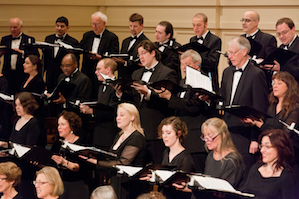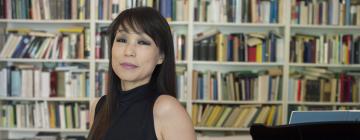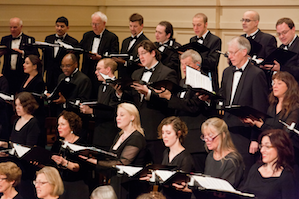
The San Francisco Bach Choir presented a musical history of San Francisco this weekend, with music director Corey Jamason taking the organization in a radically different direction from his specialty in early European and Baroque music to folk Americana. Members of the choir were dressed in colorful tops, lending the evening a brighter, more casual atmosphere before the music even began.
The historical narrative began in the 1840’s with a pair of songs in Spanish from the days when the place was called Yerba Buena. Soprano soloist Gina Morgano sang an aria backed up by the men of the choir. Her Yo no sé si me quieres sounded like a scene from a Verdi opera with Morgano’s voice sounding strong and rich. Alongside her was a favorite Bay Area’s tenor, Brian Thorsett, who works with practically every community choir and orchestra around. His free-flowing yet booming voice filled the Calvary Presbyterian Church with ease. Even when narrating prose interludes, his speech had a dramatic, mellifluous quality, delivered with good humor and charm. Thorsett’s specialty is his highest register, which he controls with delicate phrasing and accuracy.
The Spanish songs were a mere introduction — the concert really assumed its character with songs from the mining days, at first optimistic in the spirit of the Gold Rush, then downtrodden when geologic and geographic reality hit. Not everyone was going to strike it rich and the harshness of travel took its toll, whether by “thieving line” stage coach or by clipper ships “around the Horn.” The choir sang with a rowdy energy on San Francisco-themed words set to tunes such as Oh! Susanna and Uncle Sam’s Farm, in choral arrangements by Eric Davis. All that was missing was a fiddler and a harmonica player and maybe some off-beat foot stomping.
The choir sang with a rowdy energy All that was missing was a fiddler and a harmonica player and maybe some off-beat foot stomping.
Chronological progression continued into the “Gilded Age” with more chromatic harmony but still very much in the strophic folk style, with songs about the new train line and Golden Gate Park. The tunes and lyrics brought to life images of elegant people in their Victorian houses on streets with cable cars and horse buggies. When the 1906 earthquake hit, the songs turned somber, but brightened up again with the 1915 World's Fair and the arrival of ragtime. Jamason showed off some parlor piano ability, a different flavor of playing from his figured bass realizations. His openness to new genres is commendable, yet the elegant classical phrasing still seemed to influence this concert of folk music — the tapered endings and beautiful tone made it feel like one foot was still at the conservatory.
A sampling of jazzy songs from the 1920’s and 30’s concluded the concert, cutting the historical narrative short. What about the second half of the 20th century? The beat generation of the 50’s? The hippies of the 60’s and 70’s? Contemporary songs? And on the other end, maybe some chant from Junipero Serra’s missions and, of course, some Native American songs? Casting a wider historical net would have lent the concert more variety. The folksongs were a fun idea but 35 of them was a lot to sit through. The highlight of the concert was when children from the Walforf School joined in, and even more so when the audience was invited to sing along — that felt like the right approach to the genre.

